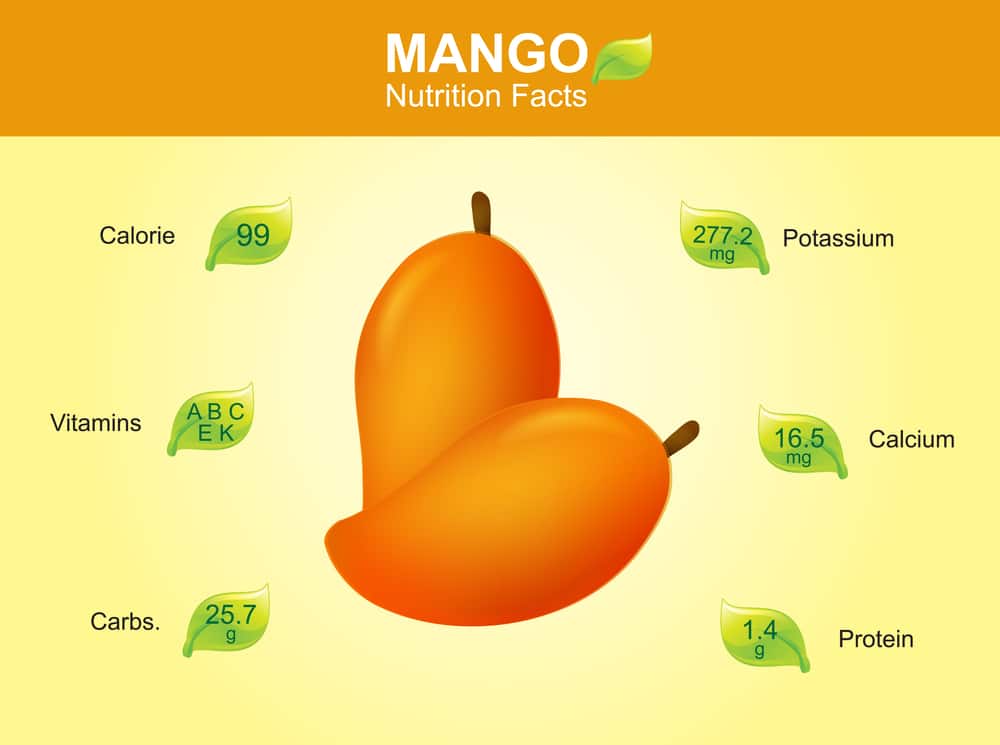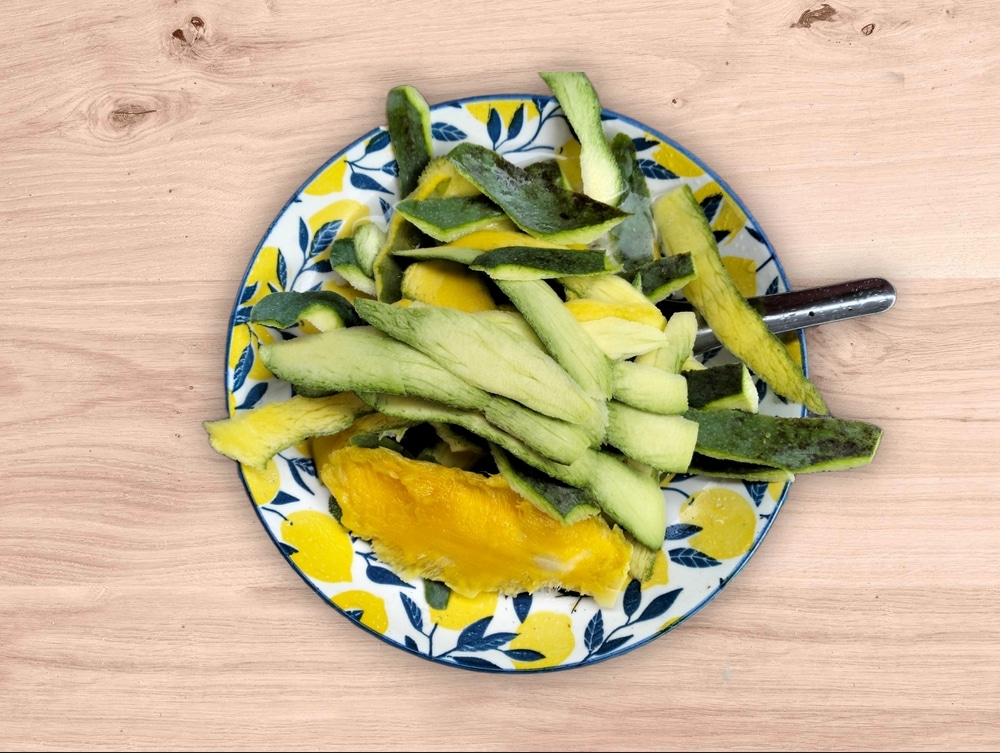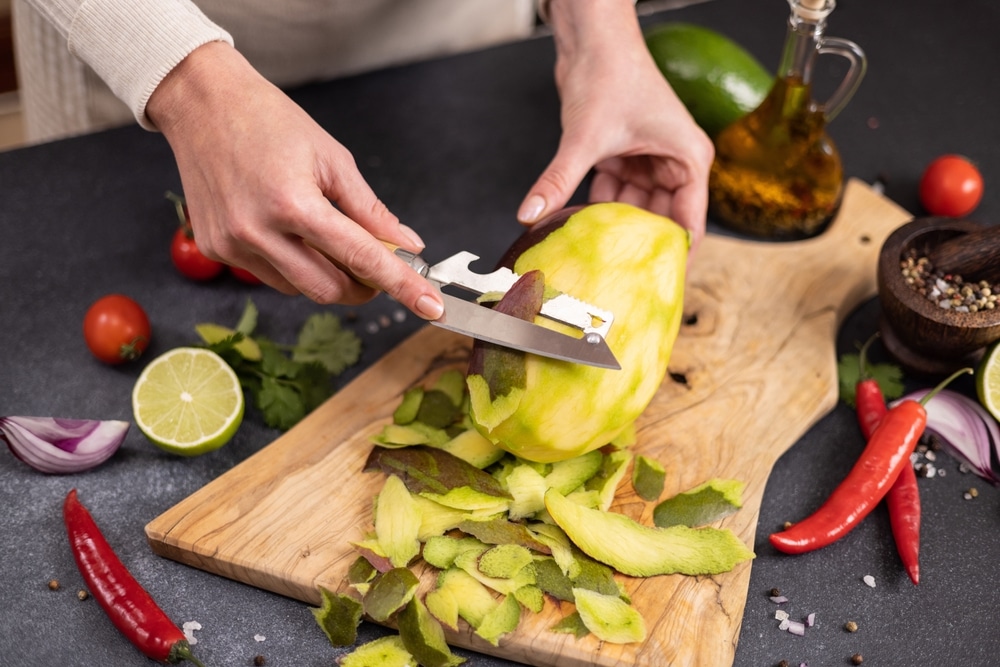Table of Contents
Mangoes, known as the king of fruits, are adored and loved for their sweetness and juicy textured pulp. Another reason for the popularity of mangoes is the nutritional wealth that they hold, but a common question arises among mango enthusiasts: Can you eat mango peel? The answer is Yes, but with certain considerations and precautions. Like mangoes, mango peels are not only safe to eat but also packed with nutrients that provide various health benefits. Yet, there are precautions to take, especially for those who are sensitive and prone to allergic reactions. Let’s dive deeper into the health benefits and potential risks of eating the skins of this delicious fruit.
Nutritional Benefits of Mango Peel

Like mangoes, mango peel is packed with a wealth of minerals and antioxidants that profoundly affect the human body. Here are some of the key nutritional components found in mango peel. Eat mango peel to consume a wealth of nutrients.
Fiber
Mango peel is rich in dietary fiber, which is crucial for digestive health. Fiber can help avoid constipation and regulate bowel motions. Increasing the amount of fiber in your diet can also help lower cholesterol and improve weight management.
Vitamins and Minerals
Mango peel contains reasonable amounts of Vitamins C, E, and A, which are necessary for strong immune systems, healthy skin, and healthy eyes. Important nutrients like magnesium and potassium are also present in the peel.
Antioxidants
Carotenoids, flavonoids, and polyphenols are among the powerful antioxidants found in mango peels. These substances lower your chance of developing chronic illnesses like cancer and heart disease while protecting your cells from oxidative stress.
Phytonutrients
The peel contains anti-inflammatory and anti-cancer phytonutrients. When you eat mango peels, these nutrients can improve general health by decreasing inflammation and possibly even lowering the risk of cancer.
Potential Benefits of Eating Mango Peel

Weight management
Mango peels’ high fiber content can help with fullness perception, which may help reduce total caloric consumption. In addition, the peel’s low-calorie content makes it a good addition to a diet for those managing their weight. If you want to lose fat and maintain a good weight, you can eat mango peel but in a certain way and follow some precautions.
Digestive Health
Mango peel fiber promotes a healthy gut microbiota in addition to helping with digestion. This can improve the body’s ability to absorb nutrients and support digestive health in general.
Blood Sugar Control
Research indicates that some chemicals found in mango peels may have a role in controlling blood sugar levels. This can be particularly beneficial for individuals with type 2 diabetes or those at risk of developing it.
Skin Health
Mango peel’s antioxidants can shield the skin from free radical damage, thereby delaying the onset of premature aging and enhancing skin elasticity.
Precautions When Eating Mango Peel

Mango peels have several health advantages, but before including them in your diet, take the following safety measures:
Pesticide Residue
Like many other fruits and vegetables, mangoes are frequently sprayed with pesticides to keep them free from illnesses and pests. These substances may stay on the peel and present a hazard if ingested. Select organic mangoes to reduce your pesticide exposure, or thoroughly wash the skin with a vinegar and water mixture.
Mango peel allergies
Mango peel allergies can occur in certain persons. This is due to urushiol, a substance also present in poison ivy, in mango skin. You should avoid eating mango peel if you have an allergy to poison ivy, oak, or sumac, or you should see a doctor first.
Digestive Discomfort
Some people may experience discomfort, bloating, or gas due to the fibrous texture of mango peel, which makes digestion difficult for them. It is best to start with a tiny bit of peel and observe how your body responds if you have a sensitive stomach.
Taste and feel
Some people find mango skin unappealing because of its bitter and occasionally rough feel. If you can’t stand the taste, consider adding the peel to smoothies or other recipes where its flavor can be subdued.
How to Safely Eat Mango Peel

In case you’ve made the decision to experiment with mango peel, here are some guidelines for secure and pleasurable integration of mango peel into your daily diet.
Blend
Like a mango smoothie, adding mango peel to a smoothie is one of the simplest ways to eat it. This lets you take advantage of the advantages without dealing with the rough texture. Blend the peel into a smoothie with other tropical fruits like pineapple or bananas, berries, or spinach for a nutrient-packed drink to mask the bitterness.
Dry and Powder
The peel can be turned into a nutrient-rich supplement for smoothies, yogurt, or even salads by dehydrating it and grounding it into a powder.
Cook with It
Add mango peel to recipes to help soften and lessen its bitter qualities. Peel and thinly slice, then add to a fruit salad to give it a crisp texture. For example, you can cook it into chutneys, sauces, or soups.
Infuse Water
Another easy technique is to add mango peel to water and allow it to infuse. This can help you consume some of the healthy components and give your water a mild flavor boost.
Conclusion
So, have you got the answer to your question, “Can you eat mango peel? Yes, you can eat mango peels like you enjoy mangoes, which have the same nutrition and health benefits as mangoes. Although mango peels are rich in nutrients, vitamins, and antioxidants, the slightly bitter taste and potential for an allergic reaction due to their similarity to poison ivy should be taken into consideration. By following the ways to safely eat mango peels, you can enjoy the benefits without the risks. To get the most out of your tropical fruits, don’t be afraid to try eating the skins of mangoes.

